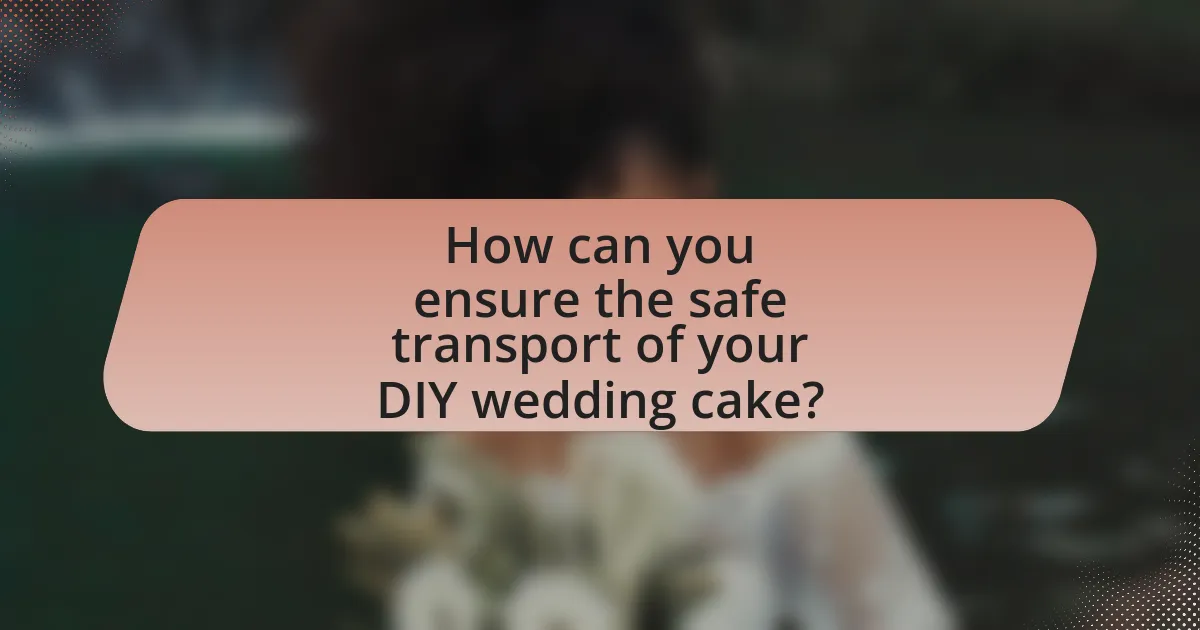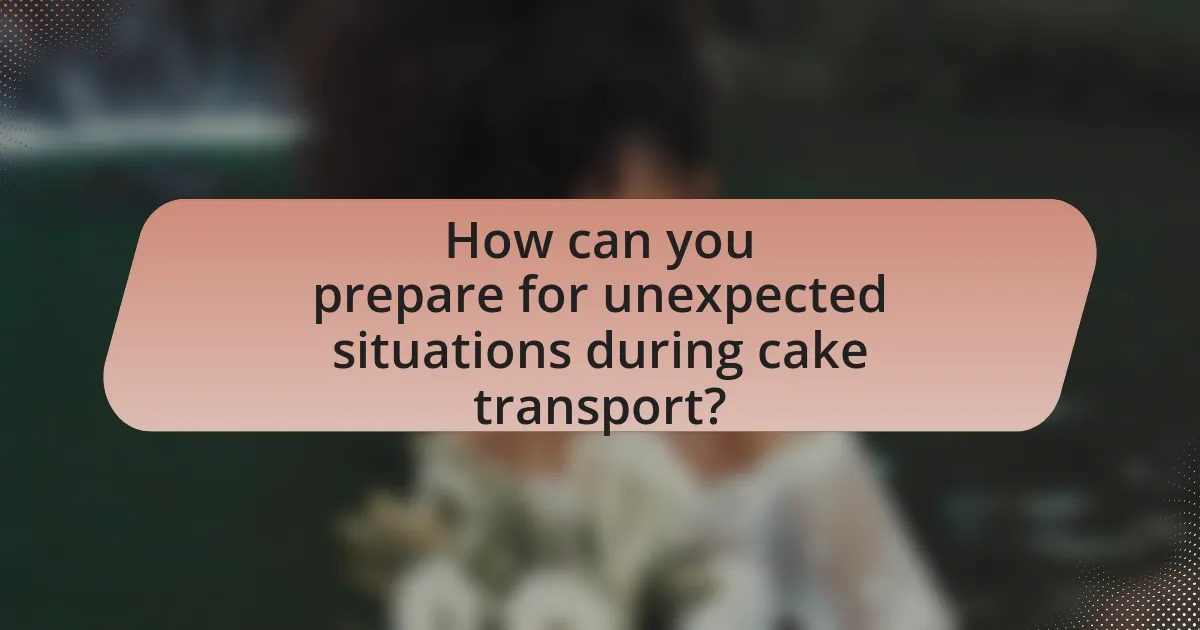The article focuses on the essential guidelines for safely transporting a DIY wedding cake. It emphasizes the importance of using a sturdy cake box, securing the cake with non-slip mats, and maintaining a stable temperature during transit to prevent damage. Key steps include preparing the cake for transport, choosing the right box, and employing best practices for loading and securing the cake in a vehicle. Additionally, the article addresses common challenges, potential risks, and quick fixes for any issues that may arise during transport, ensuring the cake arrives intact and ready for the celebration.

How can you ensure the safe transport of your DIY wedding cake?
To ensure the safe transport of your DIY wedding cake, use a sturdy cake box or carrier specifically designed for cakes. This type of container provides essential support and protection against movement and external pressure during transport. Additionally, secure the cake with non-slip mats or cake boards to prevent sliding, and keep the cake level to avoid any tilting that could cause damage. According to baking experts, maintaining a stable temperature is crucial; therefore, transport the cake in a climate-controlled vehicle to prevent melting or structural failure.
What are the essential steps to prepare your cake for transport?
To prepare your cake for transport, first ensure it is completely cooled and set. Cooling prevents melting and structural collapse during transit. Next, securely place the cake on a sturdy cake board that is larger than the cake itself, providing stability. After that, cover the cake with plastic wrap or a cake box to protect it from contaminants and damage. If the cake has multiple tiers, stack them only at the destination to avoid shifting. Finally, transport the cake in a flat, stable surface, such as the trunk of a car, and avoid sharp turns or sudden stops to maintain its integrity.
How should you choose the right cake box for your wedding cake?
To choose the right cake box for your wedding cake, select a box that is sturdy, appropriately sized, and designed for cake transport. A sturdy box ensures that the cake remains stable during transit, while the correct size prevents movement that could lead to damage. Cake boxes specifically designed for transport often feature reinforced corners and secure closures, which help protect the cake from external elements. Additionally, using a box with a flat base is crucial, as it provides a stable foundation that minimizes the risk of the cake shifting or collapsing.
What tools and materials do you need for safe transport?
To ensure safe transport of a DIY wedding cake, essential tools and materials include a sturdy cake box, non-slip cake board, and cake dowels. A sturdy cake box provides structural support and protects the cake from external elements during transit. The non-slip cake board prevents the cake from sliding, while cake dowels reinforce stability, especially for multi-tiered cakes. These components collectively minimize the risk of damage, ensuring the cake arrives intact.
Why is it important to consider the temperature during transport?
Considering temperature during transport is crucial to maintain the integrity and quality of a wedding cake. Temperature fluctuations can cause frosting to melt, fillings to spoil, and structural integrity to weaken, leading to a compromised appearance and taste. For instance, cakes with perishable ingredients, such as cream cheese or fresh fruit, should be kept at temperatures below 40°F to prevent bacterial growth, as recommended by the USDA. Therefore, monitoring and controlling temperature during transport ensures the cake remains safe for consumption and visually appealing for the event.
How can you maintain the ideal temperature for your cake?
To maintain the ideal temperature for your cake, keep it in a controlled environment between 70°F to 75°F (21°C to 24°C). This temperature range prevents melting of frosting and ensures the cake remains moist. Using insulated cake carriers or boxes can help regulate temperature during transport. Additionally, avoid placing the cake in direct sunlight or near heat sources, as these conditions can raise the temperature and compromise the cake’s integrity.
What are the risks of temperature fluctuations during transport?
Temperature fluctuations during transport pose significant risks to the integrity and quality of a wedding cake. These fluctuations can lead to structural instability, causing the cake to collapse or deform, particularly if it contains delicate elements like fondant or buttercream. Additionally, temperature changes can result in melting or hardening of ingredients, which affects texture and flavor. For instance, a study published in the Journal of Food Science indicates that cakes exposed to temperatures above 70°F can experience rapid spoilage due to bacterial growth, compromising food safety. Therefore, maintaining a consistent temperature is crucial to ensure the cake remains visually appealing and safe for consumption.
What are the best practices for loading and securing your cake in the vehicle?
The best practices for loading and securing your cake in the vehicle include using a sturdy cake box, placing the cake on a flat surface, and securing it with seat belts. A sturdy cake box protects the cake from external elements and minimizes movement during transport. Placing the cake on a flat surface, such as the floor or a flat seat, prevents it from tipping over. Securing the cake with seat belts ensures it remains stable and reduces the risk of damage from sudden stops or turns. These methods are widely recommended by professional bakers and event planners to ensure safe transport of cakes.
How can you prevent movement and damage while driving?
To prevent movement and damage while driving, secure the cake in a stable, flat position using a non-slip mat or cake box. This method minimizes vibrations and sudden shifts that can cause the cake to slide or topple. Additionally, placing the cake on the floor of the vehicle rather than on a seat can further reduce movement, as the floor generally experiences less motion. Research indicates that securing items during transport significantly decreases the risk of damage, as evidenced by studies showing that properly secured cargo reduces accidents and spills by up to 50%.
What should you do if you encounter bumps or turns on the way?
If you encounter bumps or turns on the way while transporting a DIY wedding cake, you should reduce speed and maintain a steady grip on the cake to prevent it from shifting. This action minimizes the risk of damage to the cake’s structure and decoration. Research indicates that sudden movements can lead to misalignment or collapse of multi-tiered cakes, emphasizing the importance of careful handling during transport.

What common challenges might you face when transporting a DIY wedding cake?
Transporting a DIY wedding cake presents several common challenges, including structural integrity, temperature control, and stability during transit. The cake’s multi-tiered design can lead to potential collapse if not properly supported, as cakes can weigh significantly and require adequate reinforcement. Additionally, maintaining the appropriate temperature is crucial; cakes with perishable fillings or frostings can spoil if exposed to heat, while cold conditions can cause condensation and damage the icing. Finally, ensuring the cake remains stable during transport is essential; sudden stops or sharp turns can cause shifting, leading to misalignment or damage. These challenges necessitate careful planning and execution to ensure the cake arrives intact and in optimal condition.
How can you avoid cake damage during transport?
To avoid cake damage during transport, securely box the cake in a sturdy, appropriately sized cake box. This prevents movement and protects the cake from external pressure. Additionally, use non-slip mats or a flat surface in the vehicle to stabilize the box, minimizing vibrations and shifts during transit. Research indicates that cakes transported in well-structured boxes experience significantly less damage compared to those without proper support, highlighting the importance of using the right materials and techniques for safe transport.
What are the most common types of cake damage to watch for?
The most common types of cake damage to watch for include structural collapse, surface cracking, and frosting smudging. Structural collapse occurs when the cake layers are not adequately supported, leading to a fall or sagging. Surface cracking can happen due to temperature changes or improper handling, resulting in visible fissures on the cake’s exterior. Frosting smudging typically occurs during transport if the cake is not secured properly, causing the icing to smear or lose its design. These damages can compromise the cake’s appearance and integrity, making it essential to take precautions during transport.
How can you fix minor damages if they occur?
To fix minor damages to a DIY wedding cake during transport, immediately assess the damage and use a small amount of frosting to repair cracks or breaks. This method is effective because frosting acts as both an adhesive and a cosmetic cover, restoring the cake’s appearance. For example, if a piece of cake has broken off, gently press it back into place and smooth the edges with frosting to blend it seamlessly. Additionally, if the cake’s fondant has torn, you can use a small piece of fondant to patch the area, ensuring it adheres well by lightly moistening the surface. This approach is validated by cake decorating practices that emphasize the use of frosting and fondant for repairs, ensuring the cake remains visually appealing and structurally sound.
What should you do if you are transporting a multi-tier cake?
To transport a multi-tier cake, secure each tier with dowels or supports to prevent shifting during transit. This method stabilizes the cake and minimizes the risk of collapse, which is crucial for maintaining its structure. Additionally, place the cake in a sturdy, flat box or on a non-slip mat in the vehicle to further ensure stability. Using a vehicle with a flat surface and avoiding sharp turns or sudden stops will help preserve the cake’s integrity during transportation.
How can you ensure stability for each tier during transport?
To ensure stability for each tier during transport, use dowels or supports to reinforce the structure of the cake. Dowels, typically made of plastic or wood, are inserted into the lower tiers to provide a sturdy base for the upper tiers, preventing them from collapsing or shifting. Additionally, securing each tier with cake boards and using a non-slip mat in the transport vehicle can further enhance stability. Research indicates that cakes with proper internal support are less likely to suffer damage during transit, as evidenced by successful transport practices in professional bakeries.
What are the best methods for assembling the cake on-site?
The best methods for assembling the cake on-site include using a sturdy cake board, ensuring all layers are level, and applying a thin layer of frosting between layers for stability. A sturdy cake board provides a solid base that supports the weight of the cake, preventing it from collapsing during assembly. Leveling each layer ensures that the cake stands evenly, reducing the risk of tilting or sliding. Additionally, a thin layer of frosting acts as an adhesive, securing the layers together and enhancing stability. These methods are widely recommended by professional bakers and cake decorators to ensure successful on-site assembly.

How can you prepare for unexpected situations during cake transport?
To prepare for unexpected situations during cake transport, secure the cake in a sturdy, non-slip box that minimizes movement. This ensures stability and reduces the risk of damage from sudden stops or turns. Additionally, keep essential tools such as a spatula, extra frosting, and cake repair kits on hand to address any potential issues like cracks or shifts in decoration. Research indicates that using a cake carrier with a locking mechanism can further protect the cake from external impacts, enhancing its safety during transit.
What emergency supplies should you have on hand?
You should have a first aid kit, flashlight, batteries, non-perishable food, water, and a multi-tool on hand for emergencies. These supplies are essential for addressing immediate health needs, providing light during power outages, sustaining energy, and performing basic repairs. According to the Federal Emergency Management Agency (FEMA), having these items can significantly improve safety and preparedness during unexpected situations.
How can you create a cake repair kit for transport?
To create a cake repair kit for transport, include essential items such as a small tub of frosting, a spatula, a set of cake dowels, and a roll of fondant. These items allow for quick fixes to any damage that may occur during transit, such as cracks or breaks in the cake structure. The frosting can be used to adhere broken pieces together, while the dowels provide structural support if the cake layers shift. Having fondant on hand allows for covering up any imperfections or gaps that may appear. This kit ensures that you can address common transport issues effectively, maintaining the cake’s appearance and integrity upon arrival.
What quick fixes can you implement if something goes wrong?
If something goes wrong while transporting your DIY wedding cake, you can implement quick fixes such as using a cake repair kit, which includes tools like icing, spatulas, and dowels to stabilize and mend any damage. For instance, if the cake layers shift, inserting dowels can help secure them in place, preventing further movement. Additionally, if the icing melts or smudges, applying a fresh layer of icing can restore its appearance. These methods are effective because they allow for immediate correction of common issues that arise during transport, ensuring the cake remains presentable and intact for the event.
What tips can help ensure a smooth delivery of your DIY wedding cake?
To ensure a smooth delivery of your DIY wedding cake, securely transport it in a sturdy, well-ventilated box that prevents movement. Using a box specifically designed for cakes helps maintain stability and protects against temperature changes. Additionally, place non-slip mats or a damp towel under the cake box in the vehicle to minimize sliding during transit. It is also advisable to keep the cake level and avoid sharp turns or sudden stops while driving. These practices are supported by cake transport guidelines from professional bakers, which emphasize the importance of stability and temperature control to prevent damage.
How can you communicate with your delivery team or helpers effectively?
To communicate effectively with your delivery team or helpers, establish clear and concise instructions regarding the transportation of the DIY wedding cake. Use specific language to outline the steps involved, such as the route to take, handling procedures, and timing for delivery. For instance, providing a checklist can help ensure that all necessary items are packed and that everyone understands their responsibilities. Studies show that clear communication reduces errors and enhances teamwork, which is crucial in high-stakes situations like transporting a wedding cake.
What are the final checks to perform before leaving for the venue?
Before leaving for the venue, ensure that the wedding cake is securely boxed and stabilized to prevent movement during transport. Check that the cake is properly cooled and set, as this helps maintain its structure. Confirm that all necessary tools and supplies, such as cake stands, serving utensils, and any decorations, are packed. Additionally, verify the transportation route and estimated travel time to avoid delays. These checks are crucial to ensure the cake arrives intact and ready for the celebration.
